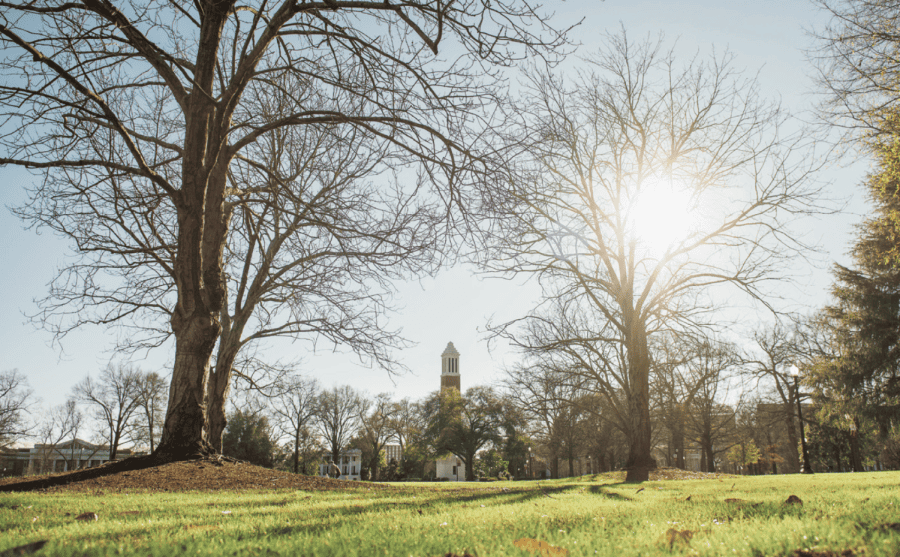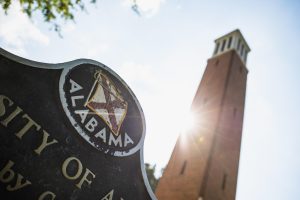Landscaping and grounds staff impact UA’s natural environment
The trees on the Quad are part of the collection of over 12,000 trees on the campus that earned UA the title of Tree Campus USA for the seventh consecutive year.
April 20, 2022
Year-round, The University of Alabama’s facilities and grounds employees work to create and maintain the Capstone’s lush landscape.
From the beds of blooming flowers that surround various building entrances to the vibrant green grass and picturesque trees that cover the Quad, the scenery around campus draws in tourists and students alike. Southern Living highlighted it as one of “The South’s Most Beautiful Colleges.”
The University of Alabama was named Tree Campus USA for the seventh consecutive year.
The facilities and grounds department has been ranked the No. 1 grounds department among 100 universities across the nation and even received an award for effective and innovative practices from the Association of Physical Plant Administrators.
“We have over 12,000 trees, so it’s a big deal to take care of our trees and be recognized for that year in and year out,” said Bryant Anderson, the director of the grounds department.
With over 50 species of trees, the University is home to some that have been here for over 100 years. Oaks and magnolias are most prevalent, while the Chinese pistache trees are the rarest, gifted by the Queen of England in the mid-1800s.
According to the Arbor Day Foundation, having a campus that is dedicated to cultivating an environment with many trees, flowers and plants can help absorb carbon dioxide in the atmosphere, reduce amounts of energy used on campus, provide mental health benefits to students and staff, and encourage physical activity.
Josie Gillette is a freshman majoring in Spanish and economics who previously worked at a state park and currently volunteers at local parks near Tuscaloosa. She said the green space and outdoor areas drew her in when she considered attending Alabama. As a runner, she loves that the University has a large campus.
“I have heard so much from other students about how the constantly green grass makes them feel happy on a rough day, it definitely rings true for me too,” Gillette said.
In a 2019 study, researchers from the American Psychological Association found that contact with nature is connected to increased happiness and well-being and decreased mental distress. Additionally, it was shown to promote positive social interactions and a sense of meaning and purpose in life.
Anderson has been working for the University for 11 years. As director of the grounds department, he oversees over 100 grounds personnel, ranging from managers, groundskeepers, irrigation technicians, and garbage truck and street sweeper operators, to tree trimmers and landscapers.
The department has grown some as the campus expands, but Anderson said the largest challenge his team faces is taking care of such a large area of land. There are only 70 groundskeepers in charge of taking care of about 1,500 acres.
During the spring and summer, the campus rapidly grows and changes; whether it’s weeds that need to be removed or the upkeep of flowers, there is always work to be done.
While it may look less lively during the winter as the trees lose their leaves and the flowers wilt, the campus comes to life as the season transitions to spring.
Alabama has a humid, hot climate that creates issues when it comes to keeping the grass green, keeping flowers alive and keeping the large trees sufficiently watered. It can be difficult for the groundskeepers to give attention to all areas in the summer with so much land to cover.
“The biggest challenge is to keep it looking the same week to week and month to month,” Anderson said.
The employees work from 6 a.m. to 2:30 p.m. During football season, they may work for up to a month straight because game days require intensive cleanup on Saturdays and Sundays.
“We put so much work in the campus, and it doesn’t take but one football game for you to see where it has been beaten up,” Anderson said. “It all goes back to that bigger picture. It is for the good of the University, for the good of Tuscaloosa, just for the people to be able to come and enjoy themselves.”
There is a landscape strategic plan in place for the department to ensure a standard for the style of the landscaping and groundwork.
“We created a standard that is kind of like Nick Saban football,” Anderson said. “All our leadership expects the campus to look this way all the time. There is a little bit of added pressure on us to make sure we keep that standard.”
Anderson said his job requires trust between him and his employees.
“One hundred and four people are dedicated to take care of the campus and make it safe and beautiful for you all,” Anderson said. “[Students] are the reason we’re here. It’s all about making the campus look good for students, family, faculty and staff.”
Hannah Shedd, a freshman majoring in environmental science, said the large outdoor space and overall feel of the campus caught her attention and was important to her college decision.
“UA stood out to me because it didn’t feel urban, and I believe that it’s due to the many outdoor spaces on campus,” Shedd said.
Kim Byram, the associate manager of the grounds department, has seen the campus grow and change in his 11 years at the University. He is in charge of six individuals who are responsible for turf installation, planting trees and assisting with the flowers, fertilization and use of herbicides.
Byram encourages students to appreciate his department’s hard work seen by this department as they walk to class.
“Enjoy it while you’re here. You get caught up doing the things that you want to do and you miss the forest for the trees per se,” Byram said. “And that’s pun intended.”
At a landscaping conference he attended, Byram learned how other schools better manage their organic waste, which he hopes to see soon at The University of Alabama.
When it comes to being environmentally friendly, Byram said there is always more they can do.
“I would hope to use less water. We can cut back on water usage, but that might mean the landscape at periods may not look as nice, so there’s a catch there,” Byram said.
This story was published in the Environmental Edition. View the complete issue here.
Questions? Email the culture desk at culture@thecrimsonwhite.com.





















